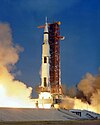Saturn V-B
Appearance
| Function | Crewed/uncrewed LEO and Lunar launch vehicle |
|---|---|
| Country of origin | United States |
| Size | |
| Height | 50 m (164 ft) |
| Diameter | 10 m (33 ft) |
| Mass | 2,313,320 kg (5,099,990 lb) |
| Stages | 1.5 |
| Capacity | |
| Payload to LEO | |
| Mass | 22,600 kg (49,800 lb) |
| Launch history | |
| Status | Concept/study |
| Launch sites | Unknown |
| Total launches | 0 |
| Booster stage – S-ID | |
| Powered by | 5 Rocketdyne F-1 |
| Maximum thrust | 30,962.50 kN (6,960,647 lbf) |
| Burn time | 154 s |
| Propellant | RP-1/LOX |
| First stage – S-ID Sustainer | |
| Powered by | 1 Rocketdyne F-1 |
| Maximum thrust | 7,740.30 kN (1,740,089 lbf) |
| Burn time | 315 s |
| Propellant | RP-1/LOX |
Studied in 1968 by Marshall Space Flight Center, the Saturn V-B was considered an interesting vehicle concept because it nearly represents a single-stage to orbit booster, but is actually a stage and a half booster just like the Atlas. The booster would achieve liftoff via five regular F-1 engines; four of the five engines on the Saturn V-B would be jettisoned and could be fully recoverable, with the sustainer stage on the rocket continuing the flight into orbit. The rocket could have had a good launch capability similar to that of the Space Shuttle if it was constructed, but it never flew.
See also
Further reading
- Saturn V-B refers to Boeing study

